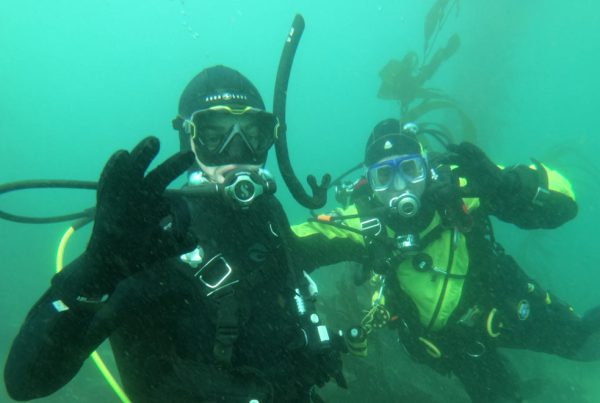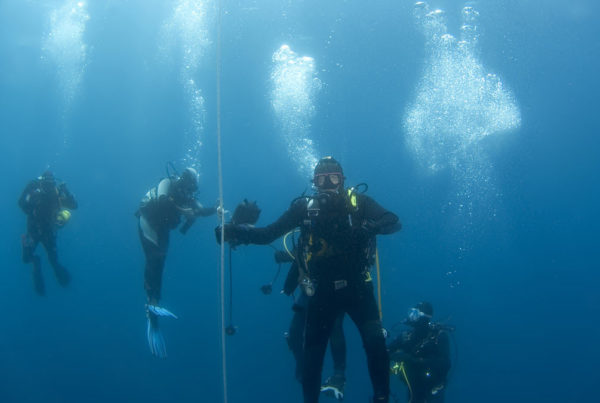At the last Avalon Harbor Underwater Cleanup, my son Eric and I were cruising across the bottom picking up the occasional bottle or can when, at 50 feet, we came across an 8-foot long dinghy. Oh, boy! I saw my son’s eyes get real big. Dreams of cleanup glory danced in his head. As he swam toward the sunken boat, I was trying to figure out how I was going to (underwater) talk him out of trying to man-handle the boat to shore. Reaching the boat before I did, he lifted it with relative ease. Now his sights were set. It was going to be very difficult to dissuade him from his goal of recovering his sunken treasure, no matter how big and unruly it was.
I lifted. It was indeed very light underwater. But being bulky, it would be a bear to handle. Fortunately, I had a small lift bag with me to make the task easier. I knew this could be done and I knew how to do it, but Eric did not. How do I convey to him—underwater—a two-minute course in underwater recovery? By example.
First, I checked both of our air supplies. Plenty. It was still early in the dive and we were going to need all the air we had. If we had less, I would not have even tried. I made sure that our air gauges were where we could monitor them frequently, and mutually, on a regular basis. Second, I set the pace— nice and slow. I had to slow Eric down a few times, gesturing him to pace his breathing—nice and slow. We checked our gauges about every two minutes and in the end, recovered the boat—to what end I am not sure, but Eric was happy and proud.
Strenuous activity while scuba diving has considerable hazards and proper precautions must be taken. It is easy to lull yourself into thinking “how hard could it be?” There are hidden dangers that can sneak up and bite you in the butt if you push your physical limits underwater.
As a sport diver, you are not a working diver. With the exception of a few light duty shallow activities, professional working divers do not use scuba. They use surface supplied breathing gas (generally in unlimited supply), communications, and standby backup divers. And they are professionally trained for strenuous underwater work.
EQUIPMENT
Your scuba equipment is very limiting. First, your breathing apparatus, specifically, your regulator, no matter how good it is, was not made to take on the rigors and demands of highly strenuous physical activity for a long period of time. Don’t push it.
Then of course there is the issue of breathing gas supply. With a scuba tank, you are limited and with intense physical activity you will suck it down quickly—a lot quicker than you can imagine, especially at depth. This has caught many divers unaware, sometimes fatally.
CARBON DIOXIDE BUILDUP
A more insidious problem, however, is carbon dioxide (CO2) buildup. With greater physical exertion comes the production of the higher production of CO2. The body senses this and breathes heavier to remove the buildup. The problem with an extreme buildup at depth is twofold. First, breathing gas becomes “thicker” at depth, particularly air or nitrox. It is simply more difficult to move air in and out of your lungs. Efficiency suffers and CO2 builds. Second, because the body only senses a percentage (as apposed to the actual high quantity) of CO2 in the blood, levels rise at depth simply because of the increased pressure.
This excess CO2 buildup problem becomes an especially severe problem on ascent. The pressure on the excess CO2 is released, the body senses the higher percentage of CO2, and responds with a higher breathing rate, a feeling of stress (which can lead to panic), and, in severe cases, one hell of a headache.
HIGHER INCIDENCE OF BENDS
And finally, extreme physical exertion underwater can lead to a greater disposition for the bends. Gas exchange is less efficient and strained muscles can trap gas more easily.
PRECAUTIONS AND PROCEDURES
BREATHING GAS SUPPLY
You should always start a dive with a full tank, but even more so if you anticipate a strenuous dive. If possible, try to use a larger breathing gas supply such as a larger tank or doubles (but keep in mind that these may also make you work harder). If strenuous diving at depth is common for you, enroll in a course that teaches specifics on estimating breathing gas consumption. Also, consider using an air integrated computer which you can set audible alarms telling you of remaining tank pressure. But the best overall approach would be the rule of thirds. Simply put, always hold 1/3 of your breathing gas in reserve.
SLOW DOWN, PACE YOURSELF
Be aware of both your breathing rate and heart rate. Underwater is not the place for intense aerobic exercise. If you sense your respiration becoming heavy, slow down and rest. Work a little, rest— work a little— rest.
AVOID UNNECESSARY EXERTION
Leverage, force and normal body strength in accomplishing difficult physical tasks underwater does not work the same as on land. As such, it is very easy to overexert yourself and strain muscles not normally used. In this straining, you leave yourself more susceptible to the bends or simply injury. Avoid unnecessary straining and if exertion take place, give yourself an extra safety margin in the decompression or no-decompression tables.
To avoid overexertion underwater, get the help of your buddy or use mechanical assistance, such as a lift bag (if properly trained in its use).
Many divers overexert themselves underwater simply fighting currents. To avoid this, hug the bottom if possible where current effects are usually less. Also, use natural features of the reef to get into the lee, out of the effects of the current. And, finally, perhaps you should consider a different dive plan. Drift diving, going with the flow during the dive and being picked up by a chase boat, could ultimately provide a more safe, enjoyable dive.









